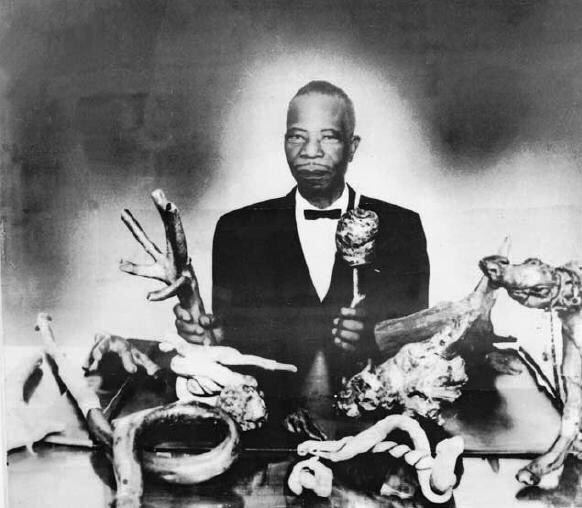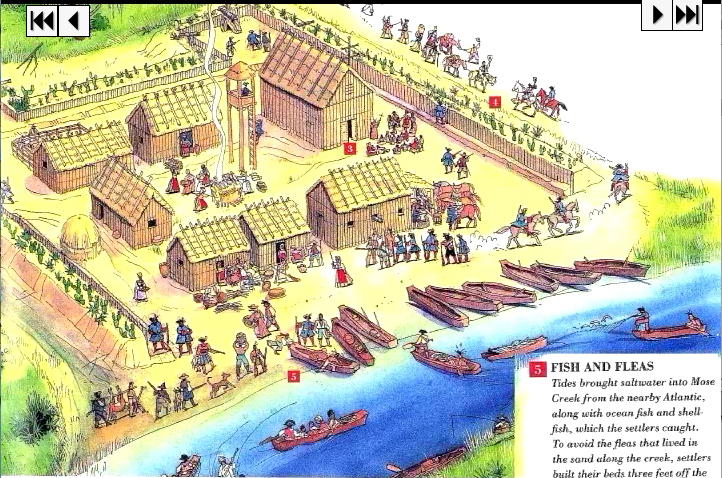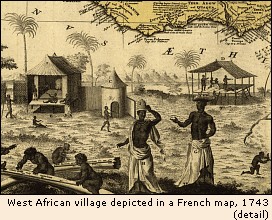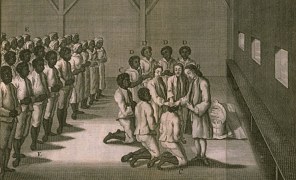1860
WHITE MAN PLANS A SLAVE INSURRECTION
A slave insurrection was planned in Winston County, Mississippi, led by a white man. The plan was to poison all the whites in the county on Election Day, take possession of the arms and fight a war of extermination of the whites. A slave girl, the property of C. D. Kelley, betrayed the plan. Forty slaves were arrested, one white man and one slave were hanged [Carroll: 1938, 198].
HUNDREDS OF SLAVES HANGED FOR INSURRECTION
Mrs. Laura S. Haviland witnessed hundred of slaves hanged in Natchez, Mississippi at the beginning of the Civil War for planning insurrection. According to her diary, a large number of slaves were hanged, owned by the following persons: Frank Susetts, 26, James Susetts, 7; Dr. Stanton, 8; Dr. Moseby, 26; widow Albert Dunbar, 48; Mrs. Brady, 12; Widow E. Baker, 28; Mrs. Alexander, 16; Dr. George Baldwin, 8; Stephen Odell, 5; G. Grafton, 5; James Brown, 3; Mr. Marshall, 1; Mr. Robinson, 2; Melon Davis, 1; widow Absalom Sharp, 3; Miss Mary Dunbar, 3; Joseph Reynolds, 3; Baker Robinson,m 3; Lee Marshall, whipped to death 1; Mrs. Chase, whipped to death 1; and total of 209 [
Woman’s Life-Work: Labors and Experiences of Laura S. Haviland. Chicago: C. V.” Waite & Company, 1887. pp. 295-298].
SLAVE REVOLT DISCOVERED IN TENNESSEE
Congressman John H. Reagan wrote his brother regarding a plot by the slaves: "A plot has been discovered in Tennessee colony, and extending out from there, between some white men and negroes, similar to that in Dallas, Ellis and Tarrant counties. Indeed, it is regarded as a part of the same plot—to poison as many people as they could on Sunday Night before the election, and on the day of the election to burn the houses and kill as many of the women and children as they could while the men were gone to the election, and then kill the men as they returned home. On last Sunday two white men, who lived up near Catfish Bayou, were hung as the ringleaders of the plot in this county. Our vigilance committees and patrol have been active here in guarding against other dangers and in investigating this matter. One negro has been hung in Henderson and one in Cherokee County, and we are informed that the town of Henderson has been burned—supposed by incendiaries—but no particulars yet. …" [John H. Reagan to Morris Reagan, August 18, 1860, in John Townsend,
The Doom of Slavery in the Union: Its Safety Out of It,Charleston, S.C., 1860. p. 34f].
TWO WHITES HANGED FOR TAMPERING WITH SLAVES
A store and post office at Lavernia were burned. Two whites, both named Boardwright, were hanged in Robertson County for “tampering with slaves." [
Northern Standard,September 22, 1860].
3 SLAVES HANGED AND WHITE MAN IMPLICATED IN PLOT
In Fannin County, three slaves named Jess, Ruben, and Emma were hanged for killing their masters. “They confessed that a general uprising of the negroes of the neighborhood had been planned, and that a white man was at the head of it. [Matagorda
Gazette, January 4, 1860.]
FIVE WHITES AND FIFTY SLAVES HANGED FOR INSURRECTION
Two hundred slaves were involved in an insurrection plot. They were to meet at LaGrange with other slaves and then fight their way to freedom and escape to Mexico. Over five whites and 50 slaves were hanged in Fayette County since July [New Orleans
Picayune, September 13, 1860]
THREE SLAVES HANGED FOR INSURRECTION
Over two hundred slaves arrested and questioned and punished by the “Committee of Vigilance.” Three leaders of the insurrection Sam Smith, Cato, and Patrick were hanged. All three met their death with composure “worthy of a better cause.” [Austin State
Gazette, July 12, 1860.]
WHITE MAN BURNT TO DEATH FOR GIVING SLAVES PISTOLS
A white man was hanged for allegedly distributing pistols to slaves. The white man was burned to death on July 29 for his actions. [Matagorda
Gazette, August 22, 1860.]
A WHITE MAN AND HIS SLAVE HANGED FOR BURING TOWN
The town of Henderson was set on fire by an incendiary and the damage was reported at over $200, 00. A local white man, Green Herndon, and a slave of his were hanged. [Matagorda
Gazette, August, 22, 1860].
SEVERAL WHITES AND BLACKS CHARGED WITH INSURRECTION
The Washington County Vigilance Committee arrested several slaves who were charged with planning, along with several whites, a “general insurrection to take place on August 6, 1860. What happened to them is not recorded. [Brenham
Enquirer, August 11, 1860.]
1861
SLAVES REVOLT WITH THE ASSISTANCES OF 5 WHITES
In Greensboro, Alabama, there was an insurrection of the slaves assisted by five white men. Four whites were killed and 16 African Americans hanged on the charge of making insurrection [Moore,
The Rebellion Records, I, 12, (Poetry and Incidents].
TWO SLAVES AND A GIRL HANGED FOR INSURRECTION
Early in June of 1861, a plan of insurrection was reported among the slaves in Monroe County, Arkansas. The plans called for the murder of all whites and in the case of resistance, the women and children were also to be killed. Several slaves were arrested. Two men and one girl was hanged [Georgia Lee Tatum,
Disloyalty in the Confederacy. Chapel Hill, 1934, p. 38].
1862
SECOND CREEK PLOT AT NATCHEZ TO KILL THE WHITES
The Second Creek plot at Natchez to kill white males and take the women as wives. When authorities learned what slaves were plotting they acted quickly and decisively by hanging every individual implicated. At least 27 slaves were hanged. The Confederate provost marshal at Natchez reported early in 1862 that 40 slaves had been hanged within that year for insurrectionary activities. Scholars will never know the exact number of insurrections just before and during the Civil War, because state governments did not reimburse owners of slaves executed at the orders of the extralegal courts. There was no official accounting because the “vigilance committees” kept quiet, and no one involved shared information on the counting of the bodies.
SERIOUS SLAVE REVOLT NEAR THIBODEAUX, LOUISIANA
About fifteen miles from Thibodeaux, Louisiana a serious slave insurrection occurred in November, which had initiated fears of a general uprising [Brigadier-General G. Weitzel to Asst. Adjutant-General G. C. Strong, November 6, 1862 in
Official Reports of the Rebellion, Series I, vol. XV, p. 172].
GENERAL BUTLER REPORTS SLAVE INSURRECTION
General Butler, while stationed in New Orleans reported a slave insurrection on August 2, 1862: “An insurrection broke out among the negroes, a few miles up the river, which caused the women of that neighborhood to apply to an armed boat, belonging to us, passing down, for aid; and the incipient revolt was stopped by informing the negroes that we should repel an attack by them upon the women and children.” [New York
Daily Tribune, August 14, 1862].
1863
FIVE SLAVES HANGED FOR KILLING THEIR MASTER
In Lynchburg, Virginia, five slaves were hanged for murdering their master General Dillard [
The Richmond Sentinel, June 25, 1863}.
SLAVES REBEL IN RICHMOND, VIRGINIA
In May of 1863, a revolt occurred among slaves working at iron works in Richmond, Virginia. Only the leaders were punished [Aptheker: 1943, 366; also in Kathleen Bruce,
Virginia Iron Manufacture in the Slave Era, p.399].
18 IMPRISONED FOR ATTEMPTED INSURRECTION
In October in Hancock County, Georgia 18 slaves were imprisoned for attempting insurrection. Few details are known about this plot
1864
SLAVE BURNT YAZOO CITY, MISSISSIPPI
In June, 1864, slaves burnt a section of Yazoo City, including 14 houses and the courthouse. It was with great difficulty that the slaves were prevented for burning the entire city [
The Richmond Sentinel, June 2, 1864].
SLAVES GIVE MASTER FIVE HUNDRED LASHES
On a plantation in Choctaw County, Mississippi the slaves rebelled and turn the table of their master Nat Best, giving him 500 lashes [
The Richmond Sentinel, June 2, 1864].
SLAVE REBELS AND RUN TOWARD UNION LINES
Early in 1864 in South Carolina an uprising of slaves occurred with the aim of getting to the Union forces. The revolt was suppressed by detachments of the Confederate Army [Letter of Major T. W. Brevard, dated Camp Finnegan, East Florida, April 2, 1863; Major W. P. Emanuel, dated between Ashepoo and Combahee, June 6, 1863 in
Official Records of the Rebellion, Series I, vol. XIV, pp. 303, 401].
*
Slave Insurrections in the United States: An Overview - SlaveRebellion.org









































